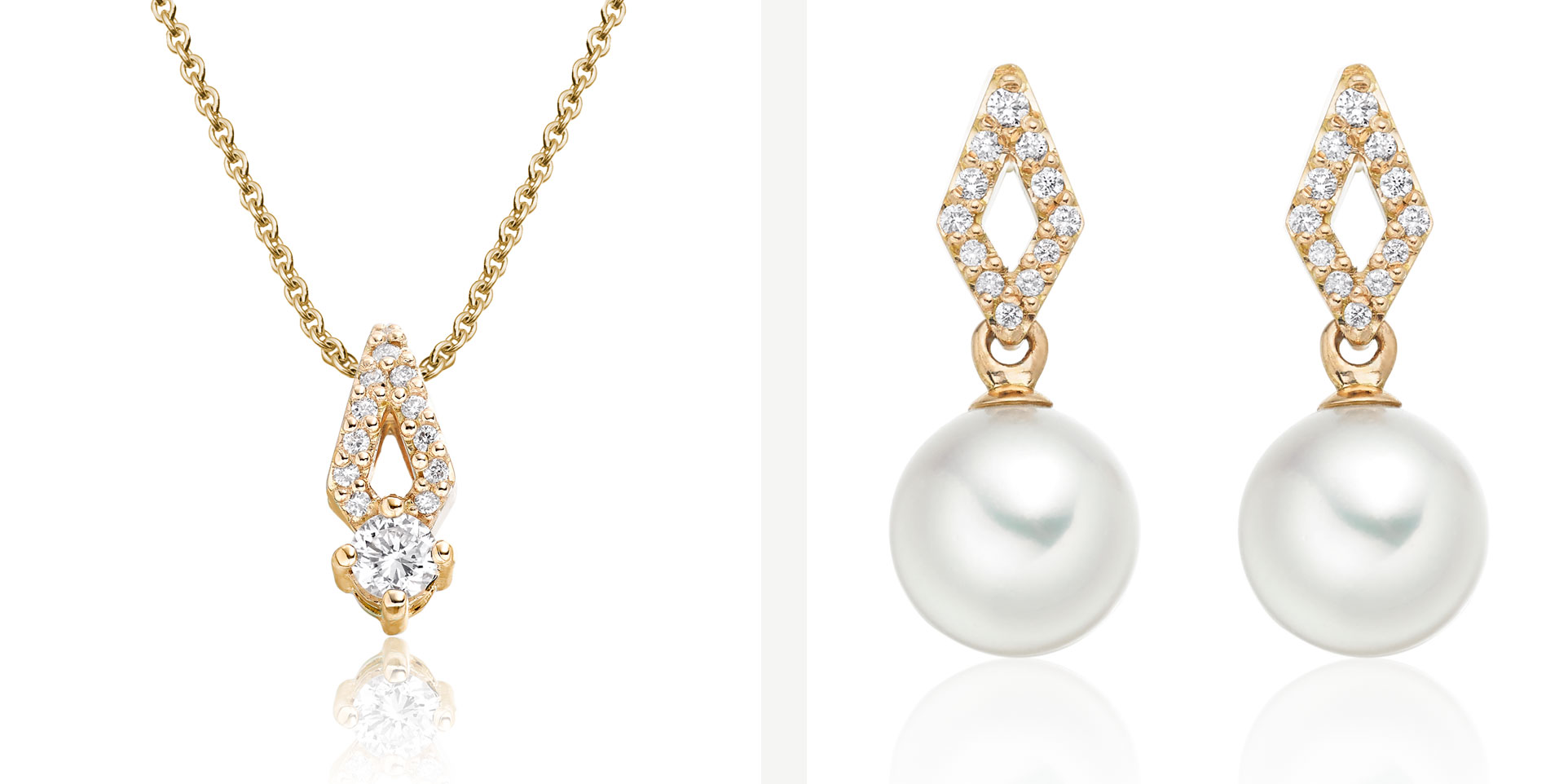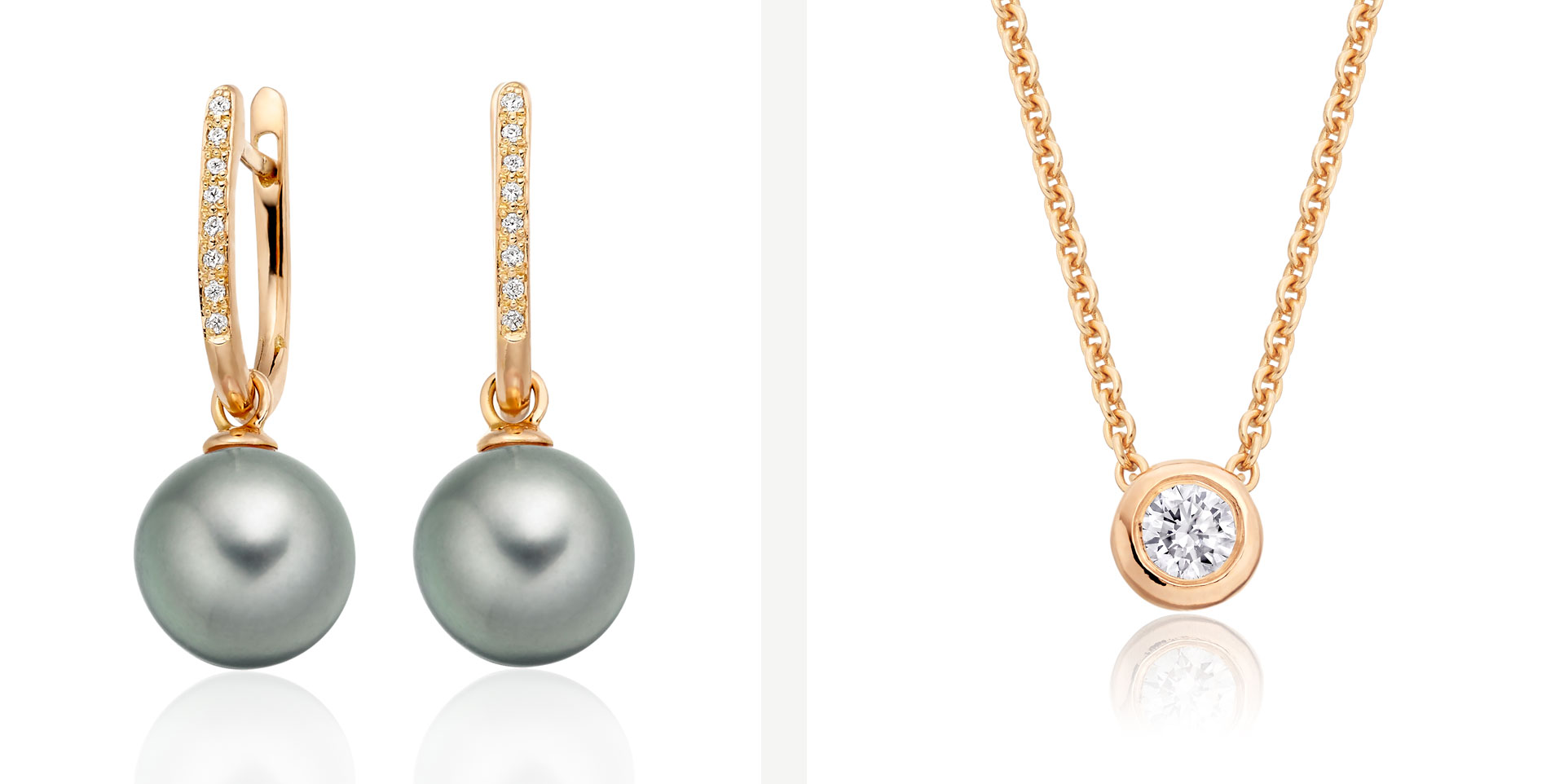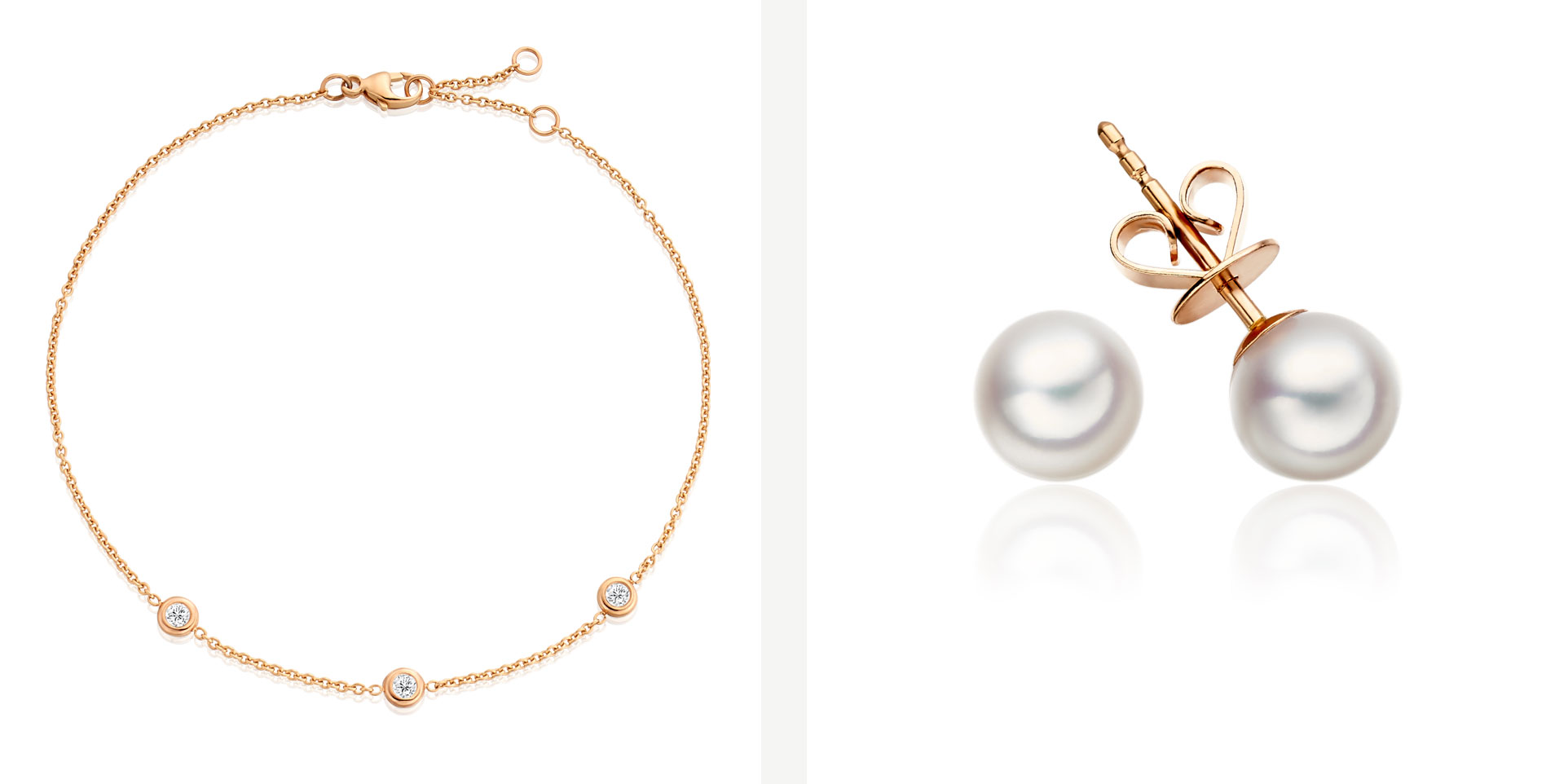Tagged with 'Precious metals'


The very latest news, musings and opinions from the world of Winterson. Quite simply, a celebration of a jewellery, fashion, culture and the business behind luxury.
-
The spectacular rise and style of Rose Gold
The spectacular rise and style of Rose Gold
What do Apple, Birkenstock, Beats and Hervé Léger all have in common? They have all succumbed to the appeal of a material that jewelers have long celebrated – rose gold.
Now a major colour trend across homeware, technology and accessories, rose gold adorns products that are as diverse as Wet N Wild lip gloss and the iPhone. Recognising its popularity, in 2016 the Pantone Institute chose a blend of warm Rose Quartz with a more tranquil Serenity blue as its Colour of the Year, influencing product design and direction.
What is rose gold?
Rose gold is a composite gold alloy of 75% yellow gold, 22.25% copper and 2.75% silver. It finds its purest form as Crown Gold, a 22 carat mix of 91.667% yellow gold and 8.333% copper. This alloy has been used to mint British Sovereign coins since Henry VIII introduced it in 1526.

Image 1: Zigzag Diamond Pendant
Image 2: Pair of Zigzag Diamond Earrings with Akoya Pearls
Variations such as pink and red gold arise from modifications to the amount of copper and silver that are added to the mix, either amplifying or lightening the dusky rose tones.
What are its origins?
The history of rose gold also finds an echo in its last golden age: in Imperial Russia at the beginning of the twentieth century. Royal jeweler, Carl Fabergé, popularized the metal as a royal favourite, creating some of his most ornamental pieces in delicate blush tones.
Most famously, the “Moscow Kremlin” egg was commissioned by Emperor Nicholas II as a gift for his wife. The gold and white enamel egg was housed within a miniature replica of Red Square’s fifteenth century Spasskaya Tower and, at 11,800 rubles, was one of Fabergé’s highest value commissions.
Rose gold rising
Symbolism is undergoing a significant and seemingly unstoppable popular revival, particularly in jewellery. The emotional impact of its colour, with all its myriad interpretations and meaning, is widely studied by designers and marketeers alike.

Image 1: Grey Tahitian Pearls with Diamond Leverback Earrings
Image 2: Classic 0.10ct Diamond Pendant
“When we get to the rose family,” says Leatrice Eiseman, the Pantone Institutes’ executive director, “we get ‘compassion, composure, warmth’, something that draws you in.”
One of the reasons for rose's popularity today is that, for consumer goods companies, this warmth has huge potential in attracting new customers. In growth markets such as China, the luxury connotations of gold and the “sense of mindfulness” that Eiseman identifies with its rose-hued cousin has significant appeal.
On trend for the autumn
In jewellery, Dior, Piaget and Van Cleef & Arpels have led the trend towards rose gold’s revival as a high jewellery material. Rose gold is a natural canvas for coloured stones, and brings delicacy as well as warmth to the traditional combination of white pearls with diamonds.
At Winterson, our Classics collection includes some of our most popular jewellery designs, that have been finished with 18 carat rose gold, white diamonds and pearls.

Image 1: Classic 0.12ct Diamond Bracelet
Image 2: Classic White Akoya Pearl Stud Earrings
There are many ways to wear this beautiful style of gold. We love the femininity of the rose gold and white diamonds of our new triple diamond bracelets and the elegant addition of light grey Tahitian pearls to our rose gold and diamond leverback earrings. The lovely combination of rose gold with the blush overtones of a white saltwater pearl in our Classic Akoya pearl studs might be the simplest and also the best.
Already a fan? Wholeheartedly embrace the trend with our striking Luna Moss ring in rose gold, green sapphire and a stunning peacock green Tahitian pearl. -
Goldsmiths Exhibit 4500 Years of Gold
Goldsmiths Exhibit 4500 Years of Gold
With thoughts of sporting British Gold later this month edging ever closer, the story of Britain's history and relationship with this precious metal is told by The Goldsmiths' Company in a fascinating new exhibition entitled "Gold: Power and Allure".
Housed in the magnificent surroundings of Goldsmiths' Hall, London, the story of our love affair with gold starts with a chance discovery of ancient goldwork near Stonehenge. Dating back to 2300BC, it is thought that these ornaments are some of the earliest pieces of worked gold found in the UK. A series of Bronze Age and Early Iron Age torcs and crescent-shaped lanula neck pieces are also really quite beautiful.
Since then, gold has been actively mined throughout England and Wales, with gold for royal wedding rings today traditionally being made from Welsh Gold. In the year of the Queen's Diamond Jubilee, the exhibition includes a number of historic and royal items including gold crowns, brooches and a rather ghoulish gold ring, that was taken from the finger of the dead Queen Elizabeth I.
Coinage explores Britain's currency and its relationship with the Gold Standard, which was introduced by Sir Isaac Newton in 1816. With the Olympics weeks away, the sporting trophies on display include a number of Olympic medals from 1900 to 1912 that are made from pure gold. These particularly rare medals compare to today's Olympic Gold medals which are cast with 92.5% silver and just 1.34% gold.
Among the more unusual gold items in the exhibition is this delightful mechanical life-size mouse made in gold and decorated with red garnet eyes and pearls. Thought to be of Swiss origin by Henri Maillardet, and dating from around 1810, it was purchased from a London dealer by John and Josephine Bowes for the sum of £22 in 1871 for their museum in Barnard Castle, County Durham.
By far the cutest exhibit in the show, the mouse measures around 11cm and is believed to be one of less than ten in the world. Wound by hand, the clockwork mouse still runs around and twitches its whiskers!
The Gold: Power and Allure exhibition is open until 28th July 2012 at Goldsmiths' Hall, London and admission is free.
-
The Lasting Allure of Gold Jewellery
The Lasting Allure of Gold Jewellery
The steady rise in the price of gold over the last five years shows an enduring fascination with this precious metal. Tutankhamun's mask, King Midas, our coinage systems, Eldorado, the Californian gold rush and even James Bond's arch rival Goldfinger are some of the icons of wealth and greed that this noble metal has helped create throughout history. What is the lasting allure of gold and its use in gold jewellery today?
Gold is a metal with remarkable properties for use in jewellery. It is a dense and durable metal being resistant to corrosion and oxidation, yet can be soft and malleable for the making of jewellery. Gold also conducts heat well and rapidly warms to our body temperature. In its purest form, gold has a bright mesmerizing yellow colour that has a sensual beauty next to the skin.
The purity of gold is defined in units of carats, which is believed to be derived from a Roman coin called a solidus that was introduced by the Emperor Diocletian around 300AD. Each coin struck had around 24 carats of gold and this sub-division continues today.
24 carat gold is the purest form of gold, with 999 parts per thousand of gold, and is generally regarded as being too soft for jewellery. To increase the metal's hardness, gold is combined with other metals to form an alloy. 18 carat gold, for example, is composed of 18 parts of pure gold and 6 parts of another metal. 14 carat and 9 carat gold have decreasing parts of pure gold and therefore are less valuable.
The alloying process also allows a jeweller to introduce other metals to influence the final colour of the alloy. The colour of pure gold is yellow, but with the addition of a metal such as palladium, the alloy will turn a silvery white that is sold with the finesse of 18 carat white gold. Alloys made with nickel and gold have been phased out in Europe since 2000 to help prevent the incidence of allergies. Other colour golds such as rose gold can be achieved with a gold alloy containing copper.
Gold is very resistant to wear and it will retain its shape and colour for generations. Most white gold jewellery sold today is also plated with rhodium, a platinum-like metal that gives white gold an additional gleam. This will start to wear within 2 to 3 years, but can be easily replaced at most jewellers.
To care for your gold jewellery, clean the gold with a soft cleaning cloth with a good quality cleaning liquid. Polish the metal with gentle, circular movements and dry off any excess liquid. Be careful however not to damage any more sensitive gems such as pearls and, if in doubt, simply clean and polish your gold jewellery with water.
As gold prices have increased, more jewellery with a lower gold finesse or silver has become popular. At Winterson, we favour 18 carat gold for its lasting value, quality and durability and all our gold jewellery is hallmarked at the London Assay office to verify its gold content. We design with either yellow or white gold to match with our Freshwater, Akoya and South Sea pearls, whilst Tahitian pearls with their dark colours have a more contemporary partnership with 18 carat white gold.
-
Hallmarking under threat ?
Hallmarking under threat ?
Reports yesterday suggested that the UK Government is reviewing the system for hallmarking with its Red Tape Challenge as its tries to reduce regulation for consumers and businesses. The historic system of hallmarking has been in use in the UK for centuries and in its present guise since 1973.
Whilst it makes sense to reduce unnecessary red tape, the hallmarking standard does provide important controls over the supply of precious metals such as silver, gold and more recently palladium in the UK.
As a result valuable items of jewellery are independently tested and marked to a standard of purity such as 18 carat gold.
Without the work of the Assay Offices in the UK, jewellery lovers and businesses alike may find that they are buying a different quality of precious metal to that which they are expecting.
We'd like hallmarking to stay. If you agree, please add your comments to the debate here.
UPDATE
On 28th July 2011, following a successful industry and consumer campaign to keep this historic practice, the Government announced that the hallmarking system would survive in its present form.
-
What is Hallmarking ?
What is Hallmarking ?
One of the oldest forms of consumer protection is the hallmark, an ancient system of identifying precious metals that is believed to date back to Byzantine traders in the 4th Century AD.
In Europe, hallmarking appeared first in France and then in the UK when in 1327 King Edward III granted a charter to the Worshipful Company of Goldsmiths to mark precious metals at their hall, giving rise to the term ‘hallmark’.
In 1973 the Hallmarking Act bound Britain to the Vienna Convention, an agreement by some European nations to standardise the control over precious metals such as silver, gold and more recently palladium. Wider international hallmarking standards and enforcement today, however, can still vary widely.
In the UK a hallmark can consist of a minimum of three symbols: a number such as 925 or 750 to indicate the purity of silver or gold, a sponsor or manufacturer’s mark and the mark of the Assay office.
Marks may be struck by a punch or etched with a high power laser. An additional hallmark called a Common Control mark can also be added and is recognised by all member countries in the Vienna Convention.
As required by law, and also where possible, all of the jewellery at Winterson is hallmarked by the London Assay office and stamped to indicate its fineness.
As an organic gem, there is an art in evaluating the quality of a pearl, its colour, lustre, shape, size and surface. In a later article, we shall look in more detail at how pearls are graded.